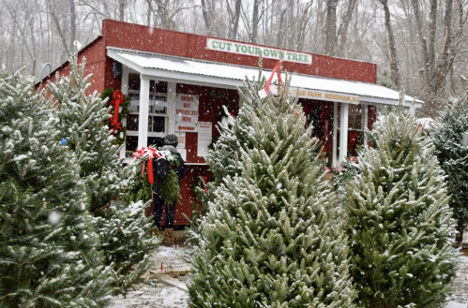
When we think of the month of December, many things come to mind – a wintery time of year here in Maryland, a month filled with major cultural holidays and, of course, the ever-present evergreen tree. Not only is it a wonderful pop of color in a leafless sea of forests here in the Mideast, but the evergreen tree represents a variety of different meanings, one of course being the icon of Christmas, the Christmas tree. The tradition of the Christmas tree dates back to the 7th century where greenery was used as a decoration in the pagan tradition of celebrating the winter solstice. However, the Christmas tree as most would know it comes from Germany where, in the 16th century, citizens of Strasbourg, Germany would harvest evergreen trees from the forest to display them in their homes in the spirit of Christmas, birthing a new tradition that forever solidified the beloved tree as an icon of the season.
The industry of Christmas tree farming provides a viable livelihood for farm and land owners, and positively stimulates local economies. Every year, the U.S and Europe combined produce around 96 million trees for harvest. Here within the U.S, consumers were estimated to have spent around $1.8 billion on live trees in 2022. The sale of evergreen trees has continued to be a viable market in the U.S economy that is bolstered by the latest advances in forestry.
Many trees harvested from the 1900s into the early 1940s were taken from natural forest stands with species like Balsam Fir (Abies balsamea) and Douglas Fir (Pseudotsuga menziesii), but to meet consumer demand that increased after WWII, Christmas tree plantations became a bigger part of the picture and more involved forest and plantation management occurred through shearing, more commonly known as pruning, to create a more dense-looking tree to meet customers’ aesthetics. Currently, over 95% of the Christmas trees we know and love come from these plantations. From a forest health standpoint, these tree farms developed practices to prevent root rot and stem cankers which can affect the integrity of the tree crop and to implement proper disease management strategies to prevent expensive losses, such as that caused by Interior Needle Blight (Dothistroma septosporum). This emphasizes the importance of proper disease management through forestry to ensure that tree farmers are able to produce high-quality trees for consumers to enjoy.
So, whether you’re spending this season crazily shopping for last minute presents, spending it with those you love, or maybe even just taking a well needed break from the business of the year, when you see a Christmas tree adorned in bright lights and ornaments, I hope you take some time to appreciate not only the tradition associated with it, but also the labor and science of forest management that continues to produce trees for us to enjoy season after season!
Information Cited from:
https://apsjournals.apsnet.org/doi/epdf/10.1094/PHP-2000-1013-01-RV
